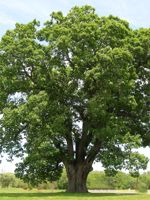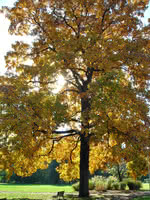Mon-Fri 9am - 5pm Mountain time
White Oak vs Shagbark Hickory
Quercus alba
Carya ovata
White Oak is large, long-lived tree with an irregular trunk divided into spreading, often horizontal, stout branches. A highly adaptable tree, White Oak features green acorns and beautiful green leaves that turn red-purple in the fall.
With a huge growth in bourbon and scotch over the past few decades there is an emerging shortage of white oak that is the primary tree used for cask barrels and aging.
Note: Most Oak species can be considered toxic for many animals.
Shagbark Hickory is a unique tree both for its looks and uses. Its bark peels into long thin vertical strips giving it a shaggy appearance. This and its golden fall leaves make it a gorgeous looking tree. This species produces tasty hickory nuts once mature. Hickory smoke is also treasured for curing meats and its generally fantastic smell.
This tree is best planted away from any buildings due to a deep taproot and large size. Many people remark on the unusual taproot for this tree that can be over 6 feet deep while the plant only has 2 feet of top growth.

